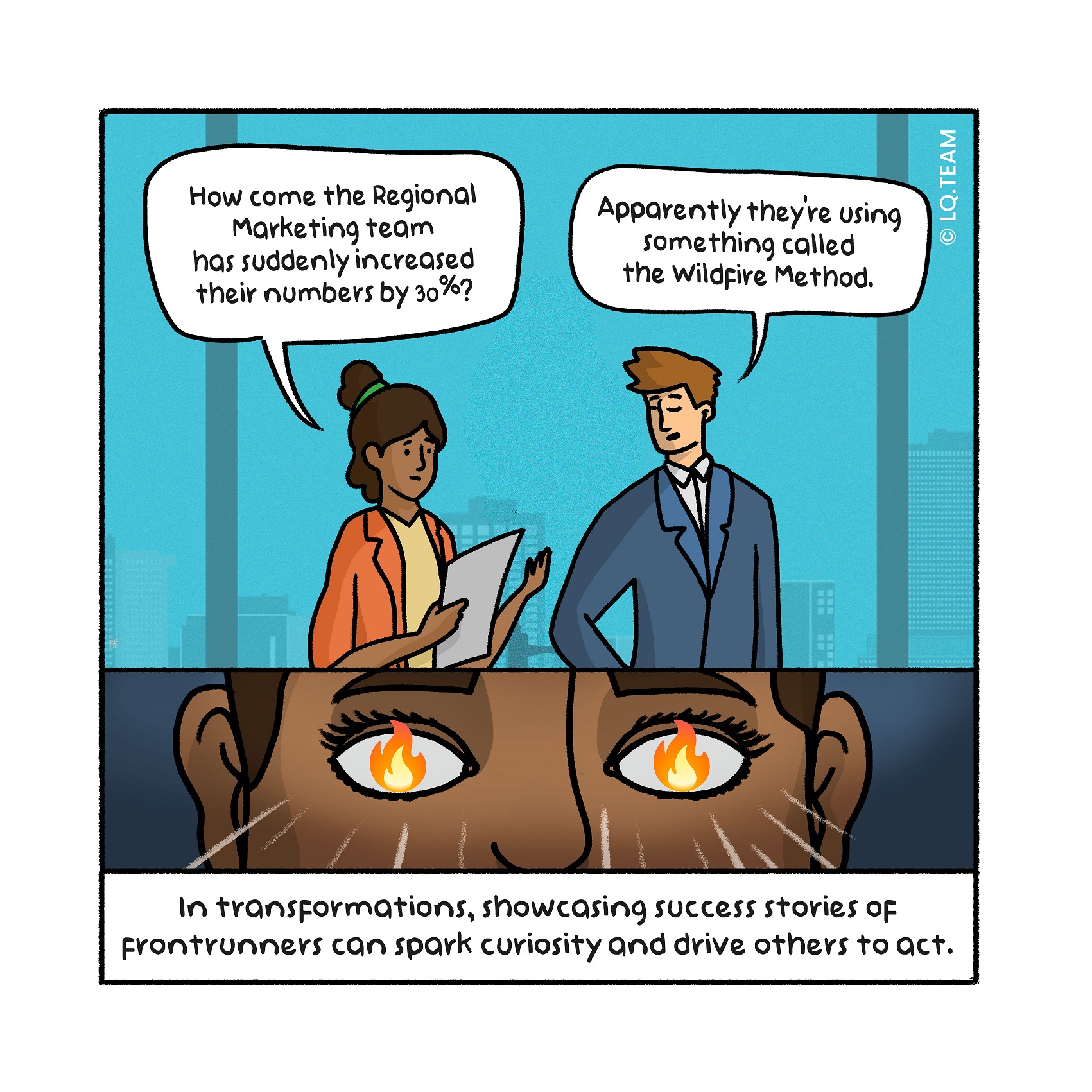
Nut to crack: How do you make success go viral?
You see a few people, a few teams or even a few business units making pro- gress on the change much faster, maybe because they have a taste for it and understand how it works, or perhaps because the change came at just the right time for them. Whatever the reasons behind those positive examples, how great would it be if you could scale them up to other areas swiftly? And even better, how wonderful is that feeling when you hardly need to do any- thing to make the change fly? But … how do you achieve that?
Nutcracker part I: Expose employees to the new and improved ways
You can only comprehend what you see and experience yourself. By expo- sing employees for a short period to a place that has already been trans- formed, they can form their judgement about the pros and cons of a change and get a more concrete picture of what the transformation does and does not entail. Often the fear of the unknown is the reason for not daring to go all in. In return, you remove that fear and provide confidence in a solution. The example below shows how.
Real-life example part I: Pull forward
Two pilot projects in streamlining business processes have proven that the change ap proach works. Processes run faster and fewer mistakes are made. The manager now wants to implement this way of working across the board. He is considering making the approach mandatory for all other teams with similar processes but assesses that more is needed to bring about the change, so instead he appoints one “implementation leader” per team. He lets these leaders work for a few weeks in the already transformed departments to experience the new working method and discover its value.
He calls this “pull forward”. The conviction and belief with which they subsequently lead the change within their teams makes the difference; within six months, everyone is working in a new way without apparent effort. Many employees were then asked what made them think the transition had gone so smoothly.
Their answer: “If a colleague believes that a new method works and is better for every one, and they convey this, it’s worth trying. That is completely different from feeling that a manager is trying to impose something on you or that a number of change managers are trying to convince you that something is good for you.”
Nutcracker part II: Use the laws of nature
To make a change go viral, you can learn from the natural laws of fire. Fire occurs when enthusiasts “ignite each other”. You create a wildfire by letting various fires burn freely. Give frontrunners maximum freedom of movement to generate fires. Fires grow when you give them oxygen and fuel. Add oxygen and fuel to encourage frontrunners to share their success stories, connect first movers with like-minded people, and inject knowledge to speed them up. Fire attracts. By making visible what the frontrunners are doing, others become curious, which makes it attractive for them to take the first steps. Like the fire brigade, they only extinguish offshoots if they endanger valuable objects. Don’t create fear or inhibitions if not needed. Does this sound too abstract? Then read the practical example.
Real-life example II: Like wildfire
The commercial director is convinced that the commercial strength of teams will in crease if they go 100 per cent digital. The commercial director wants to spread this fully digital way of working like wildfire. To achieve this, he starts with one team. This team organises a weekly comeandsee for other commercial employees. Enthusiasts can see what they are doing and how they work. He waits for one enthusiast to come to him and starts the next team with this person. He has both teams supervised by an experienced mentor. He shares and visualises the results of the teams broadly: successful conversion to paying customers and cost savings due to the work that the teams can now undertake themselves instead of having to hire expensive external parties. Others get excited. That’s when he sets up two more teams. He organises an hour every two weeks in which the team leads exchange tips and tricks. After six months, almost half of his commercial organisation has gone fully digital without being pushed.
Tip for change leader
Think outside the boundaries of your organisation. You can also consult other compa nies. Where in a different industry has the change you envisaged already taken place? Expose change leaders to that place at the beginning of the transition. This lowers the threshold to dare to act.
Tip for change enabler
Make “pull forward” standard practice in deployment plans.
Kernel: Wake up, remove barriers
This challenge is about what you can do to accelerate or spread the change. Kindle the fire, allowing the change to take flight. At the same time, remove the fear of the unknown by exposing change leaders to what the transfor- mation looks like when it has been realised. That investment pays for itself many times over.
